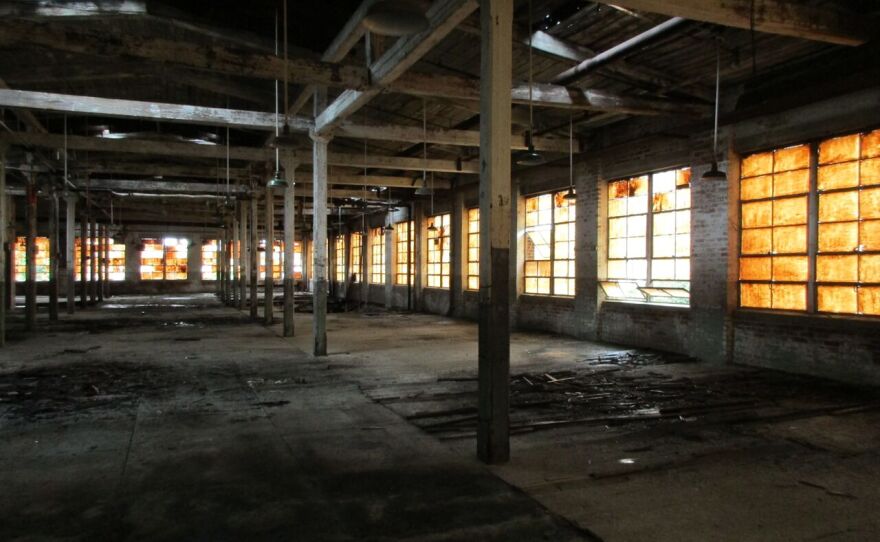There were some 500 factories in Bridgeport, Connecticut at the turn of the last century. They made products that were sold all over the world — everything from sewing machines, to ammunition, to lingerie. One of those factories, owned by the Warner Brothers Corset Company, made one of the most popular corsets in the world.

Corsets were an essential part of many women's wardrobes in the 1800s. But they weren’t exactly comfortable. They were made with steel and bone.
“And these corsets were quite dangerous," said University of Bridgeport professor Eric Lehman. "They could break your ribs; they were moving your organs around, deadening your nerves."
Two doctors were concerned about what these corsets were doing to women’s bodies. So brothers Lucien and Ira Warner designed a flexible corset made of plant fibers. It allowed women to move and breathe. The corsets were so successful that, in the late 1870s, the brothers decided to build this factory in Bridgeport to mass produce them.
“The Warner Brothers changed the industry," Lehman said. "People still made the steel and bone corsets, but [the Warner Brothers corsets] quickly became the most popular corset in the world.”
Lehman said that more than a hundred years ago, the factory was filled with mostly immigrant women making corsets.
“We would have seen rows of women at…small desks with sewing equipment," he said. "Many of these women were in here for 12 hours a day at least.”
I think, especially as a woman, the fact that these girls were working over in the factory and somebody was caring enough to give them an education, that is such an incredible thing.- Bridgeport International Academy Principal Nora Spurgin.
Many of the women who made those corsets lived across the street at a place called the Seaside Institute. The Warner Brothers built it to provide free rooms for their female workers. Today, it’s a private prep school.
The Bridgeport International Academy was founded by Nora Spurgin. Spurgin said she’s proud of the building’s history. She said the women not only lived here, they were educated here.
"This was very unusual…and it merited the president’s wife coming to open it," she said.
President Grover Cleveland’s wife, Frances, dedicated the building. Spurgin said the First Lady saw the Warner Brothers factory as an example for how companies should treat their workers. Spurgin said she feels the history every day.
“I think, especially as a woman, the fact that these girls were working over in the factory and somebody was caring enough to give them an education, that is such an incredible thing,” she said.
Lehman believes the women were mandated to take classes after their 12-hour workday, and, this way, the Warner Brothers thought they could secure their workforce. They worried the women would find husbands and leave their jobs. Lehman said the Warner Brothers did give these immigrant women an education, though, in subjects like English and civics.
“Perhaps it backfired on them when they learned how to strike later on,” he said.
More than a thousand women went on strike at the factory in 1915. They won an 8-hour workday and a pay raise. Soon, corsets would go out of fashion. And the Warners went on to make another undergarment- the brassiere. But, eventually, the company took the factory overseas, and one more abandoned building was born in Bridgeport.

The current owner of the property has the go-ahead to put up almost 350 apartments, and to make way for them, the part of the factory where the women made the corsets will soon come down, said Michael Villani, who looks after the property for The New York owner. The factory has been abandoned for four decades and it's locked behind chain link fences. Inside the old factory, paint is peeling off the damp walls. There’s no electricity, so it’s pretty dark, even in daylight.
“It is in bad shape…Structurally, it’s just rotted from years and years and years of neglect," said Michael Villani.
The factory’s fate is a major concern for Villani. The original plan was to save the oldest part of the factory. But that’s just not possible any more.
If this were Brooklyn, maybe you could turn it into a place for artists or hipsters.- Michael Villani
“It’s very expensive to renovate a building like this," he said. "It would be more money to actually fix it up than to build something new.”
If this were Brooklyn, Villani said, maybe you could turn it into a place for artists or hipsters. But this is Bridgeport, and there‘s as much demand for fixing up abandoned factories as there is for corsets.






